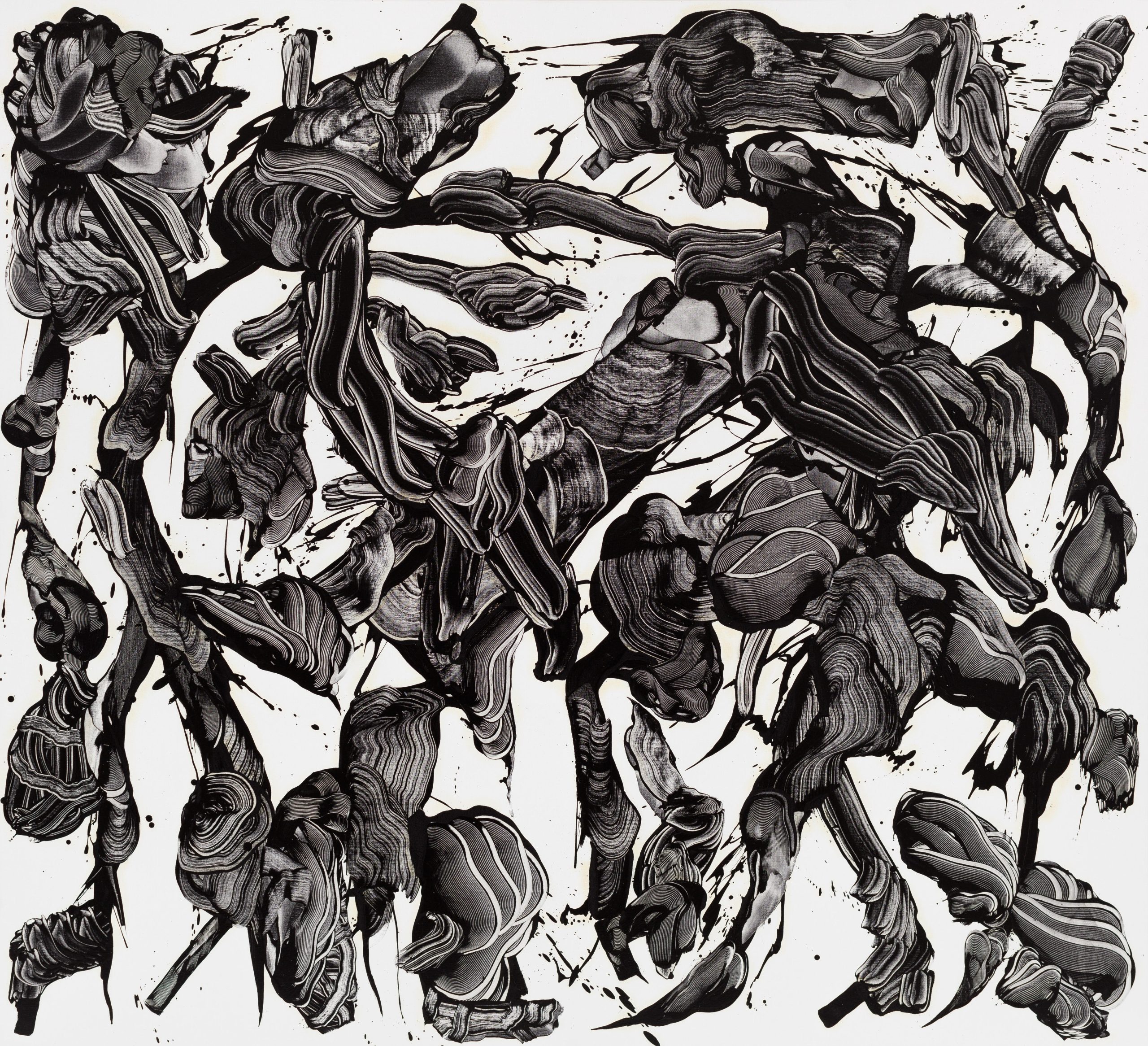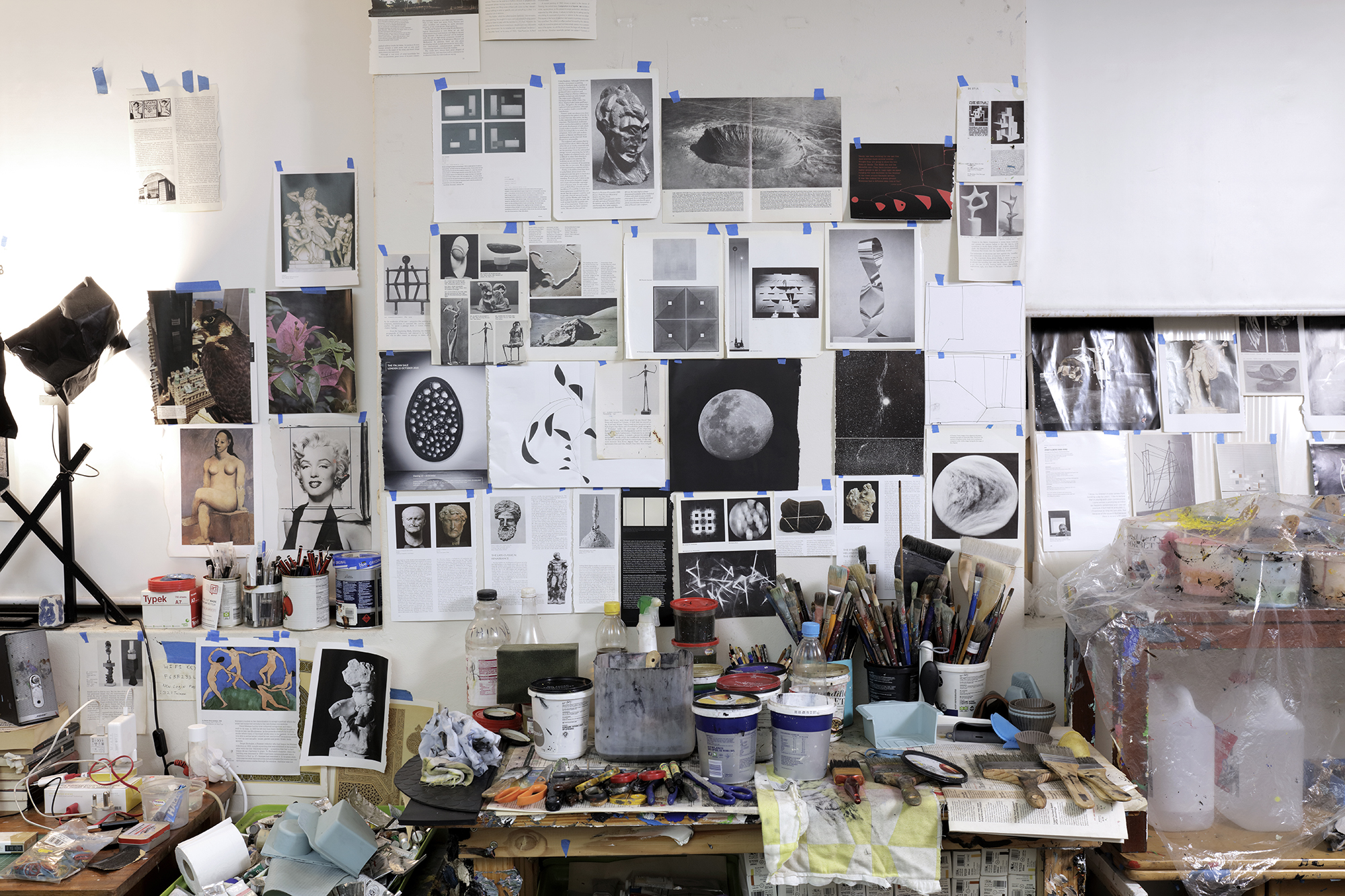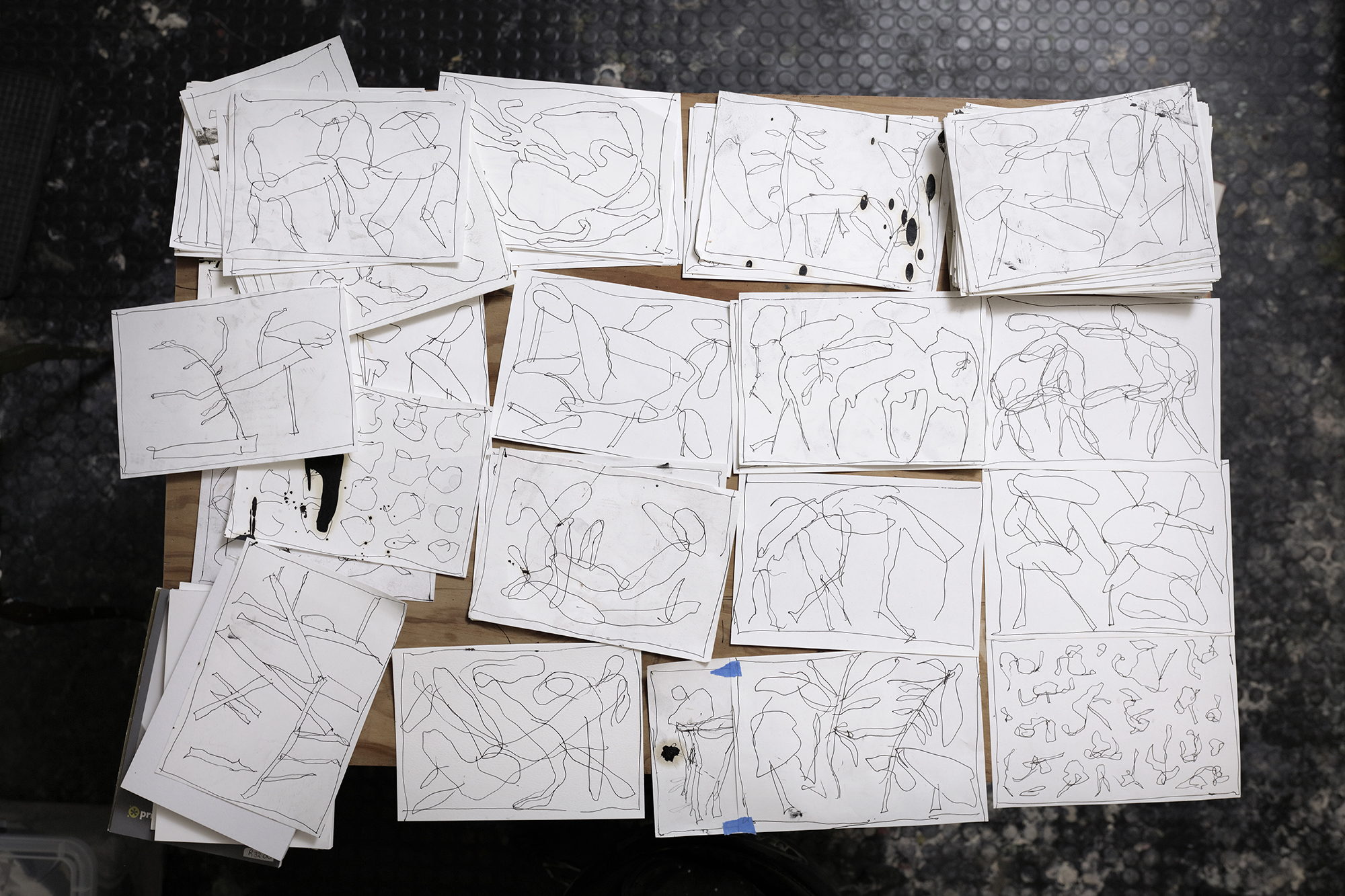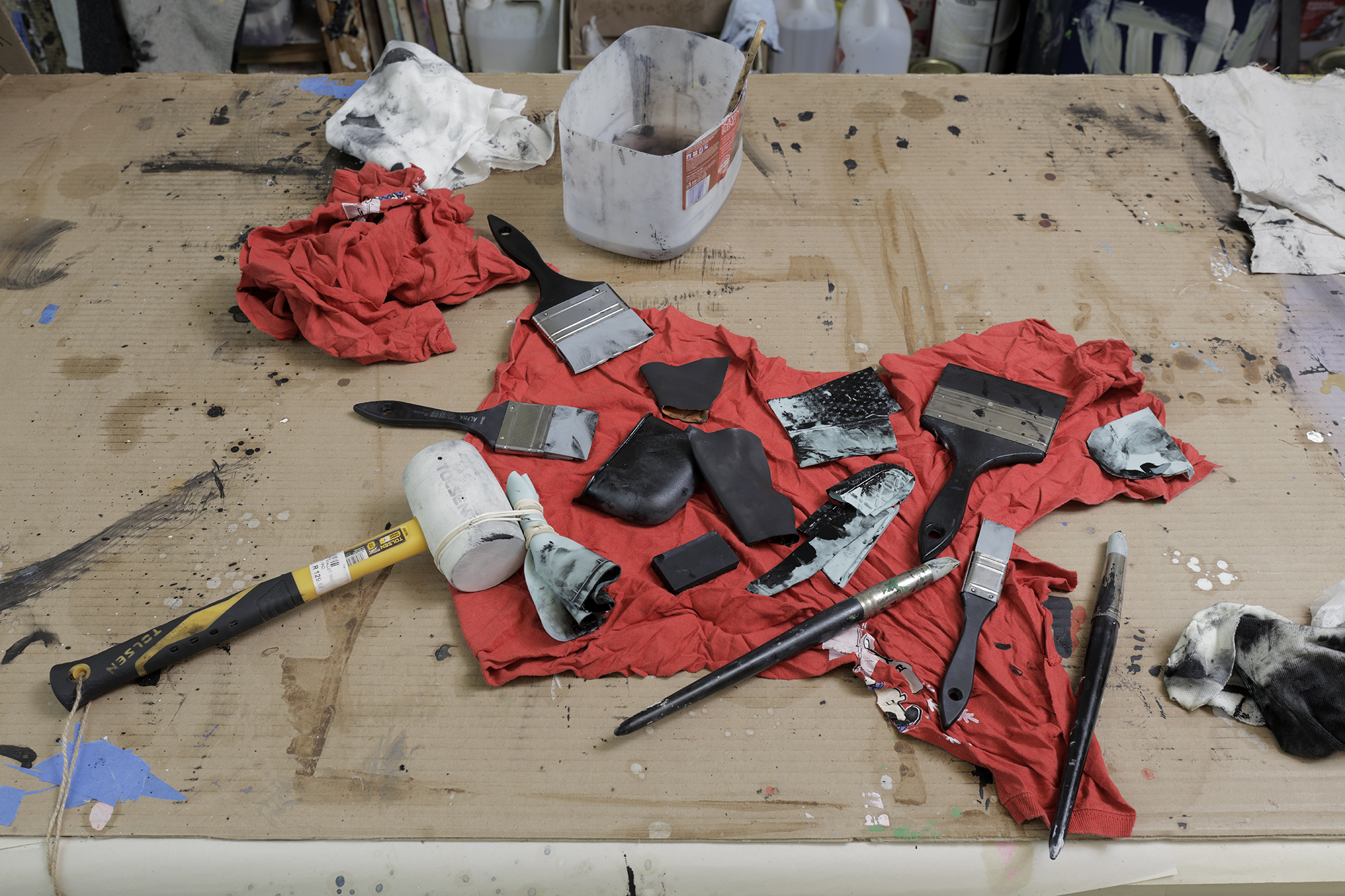From witnessing his 2021 exhibition, Garage-ism, right through to viewing the impact of his most recent solo exhibition, Monochrome Paintings, here in Johannesburg – Zander Blom’s work has always left me enthused and enthralled.
From the plethora of contemporary artistic influences and references which Blom draws from, this artist has managed to forge his own distinct signature style within the local art space.
This interview felt like such a full-circle moment for me – one in which I was finally able to unravel some answers to the questions which have riddled my subconscious ever since witnessing Garage-ism, at the Stevenson Gallery in Cape Town, for the first time.

Monochrome Paintings, 2022.
For example, Henri Matisse is one of my favourite contemporary fine artists of all-time, so witnessing certain draughtsmanship techniques in Blom’s work which resemble Matisse’s most iconic works (such as La Danse, 1909, is extremely impressive to see.
Mark Rothko, Jackson Pollock, German Expressionism, and Abstract Expressionism are also just some of the other examples which inform the palette of Blom’s artistry.
I managed to virtually engage Blom in order to understand more about the influences and inspirations for his art, his feelings towards Garage-ism relative to his latest work, Monochrome Paintings, as well as obtain some extremely wise advice for all young and emerging fine artists around.
The interview below is another resounding example of the impact which lies within Blom’s work and his developing legacy.


Photography by Nina Lieska
Would you mind introducing yourself and including a short description of what you do?
Zander Blom: I’m a painter based in Cape Town, born in 1982 in Pretoria. In the early 2000s I moved to Johannesburg and started out working with installation, drawing, printmaking and photography.
I’ve been involved in some fun group projects and collaborations over the years but the bulk of my energy has gone into my solo work. I began getting serious about painting around 2010 and that has remained my focus ever since. Within painting I’ve gone through many phases and right now I find myself in an abstract monochrome moment.
I was lucky enough to view your gallery exhibition, Garage-ism, in Cape Town and I can safely say that you are one of my favourite contemporary fine artists at the moment. What mainly inspires the art which you make?
Zander Blom: The inspiration and references change with each new series of work and can come from all over. For the Garage-ism show I was looking at medieval military technology and fables, stills from horror movies, photography from movie sets, images of homemade party costumes, children’s colouring books, gargoyles… These were found mostly online.
For the new monochrome work my references are mainly black and white photographs/reproductions from books on history, nature, outer space, art, and so on.
I have a deep interest in art history and that has remained one of the cornerstones of my references over the years. Black and white images of modernist sculpture have been very useful for the new work, and if there is one painting in particular that has informed my current compositions it is Henri Matisse’s La Danse (first version) of 1909. This reference might seem counterintuitive at first glance but if you look at the silhouette of the interlocked figures as a unit and the suggested movement it should make sense.

Henri Matisse, La Danse; 1909.

Monochrome Paintings, 2022.
Do you have a specific process when creating your art? I’ve noticed a lot of drawings and doodles which seem to form a part of your process.
Zander Blom: I find it very useful to have piles of compositional sketches around me in the studio. So, when I work on a painting, I have a lot of visual references to draw from. These sketches are usually done very quickly, and they are very basic ideas for compositions. I think of them as little blueprints or simply starting points for potential paintings.
The aesthetic of your work kind of reminds me of the great Francis Bacon – are there any artists which you draw inspiration from?
Zander Blom: There are many. Francis Bacon was one of my biggest heroes when I was a teenager and elements of his influence still linger. For the past few years I’ve been drawing a lot from Mark Rothko, Agnes Martin, Jackson Pollock, Kazuo Shiraga, Marlene Dumas, Georg Baselitz, Louise Bourgeois, Luc Tuymans, Joan Mitchell, Peter Doig, Constantin Brâncuși, Alberto Giacometti, Cy Twombly, Philip Guston, Henri Matisse, Jean Dubuffet, the Dada movement, the Gutai movement, German Expressionism, and Abstract Expressionism.
I see on your Instagram bio that you’re also represented by the Stevenson Gallery – how has your relationship been with such a reputable art gallery slash institution?
Zander Blom: I’ve worked with them for over ten years and it’s been a real privilege. They strive for a level of excellence in everything they do, from the way a show is hung, to catalogue design, to shipping and accounts, down to every mailer and Instagram post that goes out.
Working with people who are dedicated, engaged, professional and excited about what they do makes your life as an artist much easier. It allows you to really focus on your work. I was a practicing artist for many years before I started working with Stevenson so I know how lucky I’ve been and how challenging it can be out in the world without the support of a good team.

Francis Bacon, Study for a Head; 1952.
How do you feel about your latest exhibition – Monochrome Paintings – relative to Garage-ism?
Zander Blom: Garage-ism was a very liberating moment for me. I change styles quite frequently and I really wanted Garage-ism to last longer than it did, but you have to go where you feel the energy. The techniques I use now came out of the Garage-ism phase.
I pulled out one particular element that felt like it had huge potential and refined it. I feel very excited about the way I’m working now and the results I’m getting on canvas. In some ways, it’s a return to a simpler approach to painting and in others it feels like a big leap forward.
I’m able to do things now with oil paint that I couldn’t imagine 10 years ago, and it’s purely because I stumbled onto a cool set of techniques through experimentation. You can’t simply will paint into doing things it doesn’t want to do. You are only ever as good as your bag of tricks and your choice of materials. Every kind of painting technique or approach is like its own technology that allows you to do very specific and limited things.
The current ‘technology’ in the studio allows me to make paintings that have a certain kind of focus and single mindedness or confidence which wasn’t possible before. And this is giving me a lot of satisfaction.

Photography by Nina Lieska

Is there any advice which you could impart to any young emerging fine artists attempting to make a name for themselves within the industry?
Zander Blom: My playbook is from the perspective of someone who dropped out of university and didn’t even study art. I was on my way to an unhappy life in advertising when I made a U-turn. So my perspective might seem somewhat pedestrian and smacking of self-help rhetoric, but here’s my advice:
Don’t wait for opportunities to happen to you, make them happen yourself. Be proactive, reach out to other artists. Band together with friends and like minded people to create your own scene. Strength in numbers.
Work hard, immerse yourself in your work, build your own world, build your own language. Be prolific. Make new work and show it as often as you can. Don’t be afraid of failure or embarrassment. You have to start somewhere.
I’ve made loads of mediocre or embarrassing work, but without that trajectory of constantly making and showing new things I would be nowhere today. You will get better as you go along. Luck is a big part of it, not only in terms of opportunities but also in terms of the quality of your work. Be ready to receive that luck by always being an artist, always being busy in the studio and always hustling outside the studio for new opportunities, knowledge, friendships and connections.
Make it easy for other people to work with you by being open and willing to go the extra mile. Be generous with your time and energy, be generous and self-sufficient as a human being in general. No one wants to work with a grumpy or needy artist.
Work with what you’ve got. Dream big but keep your expectations low. If you can’t afford a studio, turn your bedroom or backyard into one. If you don’t have access to a gallery, show in a garage, a parking lot, or a kitchen. These places are much more exciting for an audience than the average gallery.

Monochrome Paintings, 2022.
People want to see young artists going at it against the odds, fighting for their own space in the world and searching for their own voice. If you can’t sell your work, give it away to friends to hang on their walls; don’t be too attached to your own creations – you can always make something new tomorrow, and word of mouth is a very powerful tool. If you don’t have money for materials, use cheap or discarded materials.
For years I worked with ink and paper and found objects because I couldn’t afford to work with oil paint and canvas. Even if someone gave me a big budget back then I wouldn’t have known how to use it effectively. I also organised group exhibitions with friends at any space we could find. You don’t need to ask permission – you don’t want it anyway.
If you create energy around your work and if it has any substance to it, the world will respond. The art world is always looking for exciting new talent – you might feel like you’re working in the dark, but you never know who is quietly taking note, waiting for your work to blossom. So be visible, and look busy!
Make it easy for people to invest in you early on by pricing your work low/reasonably. Once people own your work they have a vested interest in seeing your career grow. This is a great way to build an audience. And it’s a great way to get old work out of the studio to make space for new, better things to come. Make it easy for people to get in on the ground floor and support you.
If you can’t pay the rent, teach yourself a skill and have a side hustle. I did freelance illustration and design work on the side under a pseudonym for a few years before I could afford my meagre living costs by only selling work. In my case the strategy was to do as few side jobs as possible and keep my living and art material costs very low. Therefore I couldn’t afford to work with expensive canvas, paints, or cameras, but I had weeks and weeks of free time rolling out ahead of me to make drawings on paper and cardboard installations in my bedroom. I could sleep the whole day and work the whole night, obsessing over art and nothing else. You have to choose what’s more important, time or budget.
Do you want to start being an artist today with very limited tools and resources, or work a job that will one day enable you with all the tools you’ll need? This is very risky because the world might have other plans for you if you go down this road. I simply chose time because I wanted to get away from doing jobs for other people as soon as I could. The desire to have that freedom outweighed everything else.
Don’t be afraid to tell people you’re an artist. You might feel it’s pretentious or self-important to wear the label when you haven’t done much yet. But people will respect you for taking the risk and believing in yourself – they might even help you out or become supporters along the way.


Don’t expect everything to happen for you all at once. You may think that’s what you want but are you ready for big success? Is your work really good enough yet? Have you created a body of work that is complex, deep, and robust enough yet to withstand and hold that kind of attention and scrutiny? Be ambitious but honest with yourself.
Slow and steady wins the race. Be persistent, consistent and patient. And don’t be dissuaded by criticism – seek it out, make it your friend and learn from it.
There is nothing wrong with being critical of the work of others or indulging in a good art world gossip occasionally. But don’t hold grudges or get involved in bitter backbiting and infighting.
You can be friends with people whose work you don’t understand or like; people are more than what you see in their work. And don’t be envious of the success of others. Other artists and people in the art world are your friends and comrades. Make allies not enemies as much as you can.
We’re all going at it against the odds in our own way. We’re all unique, strange and sensitive creatures with our own struggles. And a life in art is a precarious business for everyone. I’ve burnt some bridges accidentally and intentionally along the way and some relationships can never be fixed no matter how hard you try. So be gentle.
Don’t get too caught up in the anxieties of your time. You don’t have to subscribe to someone else’s narrative of who and what you’re supposed to be. The politics and ideologies of the day don’t have to define who you are. Invent yourself. And keep reinventing yourself.
And lastly, have fun! Because if you stay open and curious there is a ton of fun to be had.
What are some of the things you are looking forward to in 2022?
Zander Blom: I’ve got a show in June at Signs and Symbols gallery in New York, and some work on art fairs throughout the year with Stevenson. So this year is looking pretty good for me, and I’m excited to travel again. Let’s hope the world still exists at the end of 2022.



















































